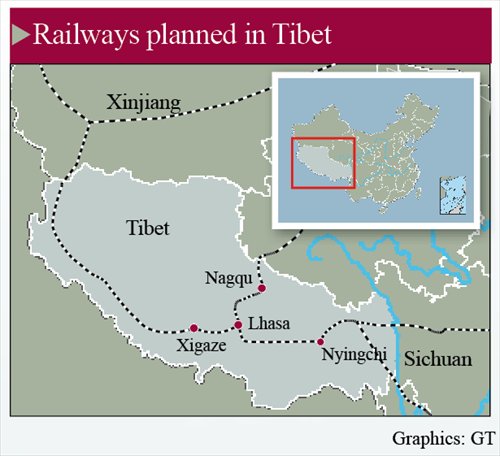
On 10th anniversary of world's highest railway, new lines planned for plateau
After operating for 10 years, the Qinghai-Tibet railway has brought employment and business opportunities to locals and numerous changes to the region. Right now, four other lines going into Tibet from other neighboring provinces are either being built or planned. The region's expanding railway network will help Tibet develop its economy, as well as help China to improve its ties with neighboring countries.
Twenty-one-year-old Phuntsok Dolma thinks her whole family has been affected by the Qinghai-Tibet railway.
The ethnic Tibetan is currently studying in Shanghai. She and her cousin have repeatedly taken trains back and forth from the coast to the Tibet Autonomous Region. But she told the Global Times that her father didn't have this luxury when he left Lhasa for his studies in 1985, because air travel was the only quick way in and out of Tibet. To save money, he only visited home once during his four years of college.
On July 1, 2006, the Qinghai-Tibet Railway, which starts in Xining, Qinghai Province and ends in Lhasa, Tibet began operating. The establishment of the railway line, which is 1,956 kilometers long, finally brought train travel to Tibet.
Friday marked the 10-year anniversary of the railway's opening. Since construction, the lives of many people living along the line have been changed. Right now, more railways and extensions are being built in Tibet, strategically knitting together the region's transportation network.
Changing the region
Before the railway was established, people and products heading to Tibet relied transportation by car or air, which was highly expensive or highly time-consuming.
Meng Fengchao, chairman of the China Railway Construction Corporation Limited (CRCC), the company building the railways going into Tibet, said many say Tibet entered an "era of railway economy" after the line was established and started running smoothly.
"Before the railway, the transportation of products and people depended greatly on cost or weather, but it's different with railway transport," he said. "It's not affected by outside factors and runs in a wide range of areas."
The railway has also brought changes to ordinary people in these areas.
When the Qinghai-Tibet railway started operating, Phuntsok Dolma was studying in middle school. She didn't take it for several years but felt familiar with it, because of all the advertisements. She heard songs about the railway on TV and read numerous news reports.
It was not until she went to high school in Shanghai in 2010, that she started riding the railway line.
"Many students in our class would ride together, we would eat instant noodles when we were hungry, the girls would cuddle together and tell each other stories to pass the night," she said. The railway has made the lives of people like her easier, as well as giving them fond memories of these trips.
In Lhasa, taxi drivers and shop owners told the Global Times reporter that their lives have been changed by the railway as well, whether directly or indirectly.
A woman said the flux of tourists that came on trains has brought her more business than before. She has a small Tibetan food and jewelry shop in the center of Lhasa, near the government headquarters.
According to statistics from the CRCC, in 2000, more than 70 million people in China travelled, but only 150,000 went to Tibet. Tourism made up of only 5 percent of the regional government's revenue for the region.
Without a railway, it was difficult to transport goods into Tibet. Before the railway was built it cost about 400 yuan (US$60) to transport a ton of coal to Qinghai from neighboring provinces, but cost 800 yuan in Lhasa. In 1978, less than 100,000 tons of materials were imported to Tibet and less than 50,000 out of Tibet.
The situation changed with the Qinghai-Tibet railway. In 2015, the railway transported more than 44 million tons of goods in and out of Tibet. In the same year, more than 11 million tourists went into Tibet on the railway, and revenue from tourism increased from 1.8 billion yuan in 2005 to 28 billion yuan in 2015.


















































